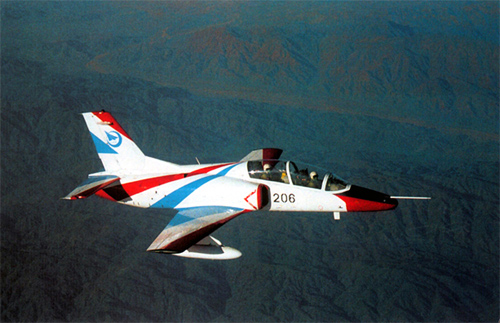JL-8
Summary
| Category | Combat Aircraft |
| Origin country | 🇨🇳 China • 🇵🇰 Pakistan |
| Manufacturer | Hongdu |
| First flight | 21 November 1990 |
| Year introduced | 1994 |
| Number produced | 500 units |
| Average unit price | $10 million |
Description
The JL-8 trainer emerged from a joint cooperation effort between Pakistan and China, proposed in 1986. The project commenced in 1987 at Nanchang Aircraft Manufacturing Company, with Shi Ping leading the Chinese engineering team and Air Cdr Muhammad Younas Tbt heading the Pakistani contingent. Initial plans included incorporating numerous US-manufactured components, such as the Garrett TFE731 engine and various cockpit and avionics systems; however, due to political circumstances and a US embargo following the Tiananmen Square protests in 1989, alternative suppliers were sought. The first prototype was completed in 1989, with its maiden flight occurring on November 21, 1990, piloted by Col Yang Yao. Flight testing continued from 1991 to 1993. After the construction of four prototypes, a limited production run of 24 aircraft was initiated in 1992.
The JL-8 / K-8 airframe is a low-wing monoplane design, primarily constructed of aluminum alloys and designed for a service life of 8,000 flight hours. The landing gear has a tricycle configuration with hydraulically operated wheel brakes and nose-wheel steering. Its flight control system operates conventional flight control surfaces through a rigid push-rod transmission system, which itself is electrically or hydraulically operated; the aileron control system is of irreversible servo-control type. The cockpit arrangement features a transparent plastic canopy covering both cockpits, which are arranged in a tandem seating position to allow for good all-round visibility. A Rockwell Collins Electronic Flight Instrument System (EFIS) is fitted, with multi-function displays (MFDs) in the front and rear cockpits. The emergency cockpit escape system consists of two Martin-Baker MK-10L rocket-assisted ejection seats that are zero-zero capable. The aircraft is equipped with ultra high frequency (UHF) and very high frequency (VHF) radio communication systems, along with a Tactical Air Navigation (TACAN), automatic direction finder (ADF), and an instrument landing system (ILS); these systems can be tailored to meet specific customer requirements. An Environmental control system (ECS) from AlliedSignal provides air conditioning to the cockpit and can operate when the aircraft is on the ground under ambient temperatures of -40 to +52 °C, as well as in the air.
The K-8 can be equipped with a variety of weapons systems. Generally, the aircraft features up to five hardpoints, four under-wing and one under-fuselage, with a total external payload capacity of 1,000 kg (2,205 lb). These hardpoints can accommodate a 23 mm cannon pod, typically mounted on the centreline. For air-to-air engagements, the K-8 can carry PL-5 or PL-7 missiles, while for ground attack, it can be equipped with 57 mm unguided rocket pods, each holding 12 rockets, as well as 200 kg or 250 kg unguided bombs. The K-8NG variant is capable of launching TL-10, TL-20, and YJ-9E air-to-ground and anti-ship missiles, and is also compatible with 50 kg or 100 kg laser-guided bombs, and can carry a targeting pod. The K-8 can also carry two 300 L (80 US gal) fuel drop-tanks on the outboard under-wing hardpoints to extend its range.
The K-8 has seen operational use in several air forces, primarily as a trainer, but also in light attack roles. It made its first public appearance at the Singapore Air Show in 1993, followed by demonstrations at air shows in Dubai, Paris, Farnborough, Bangkok, and Zhuhai. The Pakistan Air Force integrated the K-8 into its Sherdils aerobatics team in 2009, with the aircraft performing its first public display in April 2010. In Myanmar, K-8s were deployed during the Kachin conflict in late 2012 and early 2013 to strike Kachin Independence Army positions, and again in 2023 against opposition groups, with one aircraft being destroyed. In May 2024, the PLAAF Shijiazhuang Flying College concluded its training lessons with the JL-8, marking the end of the college's operational use of the aircraft.
Main Variants:
-
K-8: The original variant, it is powered by the Garrett TFE731-2A turbofan engine.
-
K-8E: Developed for export to Egypt, this variant features 33 modifications to the airframe and avionics.
-
K-8P: This is a Pakistan-specific variant equipped with new avionics, a glass cockpit, and Martin-Baker Zero-Zero ejection seats.
-
K-8V: An 'integrated flight test simulation aircraft' (IFTSA), this variant incorporates an advanced flight control computer and analogue fly-by-wire (FBW) system to mimic the aerodynamic characteristics of other aircraft.
-
JL-8: A PLAAF-specific variant that is powered by the Ivchenko AI-25 TLK turbofan and features a Chinese avionics suite.
Technical specifications
| Version: Hongdu-PAC K-8 | |
|---|---|
| Crew | 2 members |
| Operational range | 2,250 km (1,398 mi) |
| Maximum speed | 800 km/h (497 mph) |
| Wing area | 17 m² (183.0 sqft) |
| Wingspan | 9.6 m (31.6 ft) |
| Height | 4.2 m (13.8 ft) |
| Length | 11.6 m (38.1 ft) |
| Service ceiling | 13,600 m (44,619 ft) |
| Empty weight | 2,687 kg (5,924 lbs) |
| Max. takeoff weight | 4,330 kg (9,546 lbs) |
| Powerplant | 1 x turbojet Honeywell TFE731-2A-2A delivering 1633 kgf each |
Current operating countries
| Country | Units | ||
|---|---|---|---|

|
China | 181 | |

|
Egypt | 118 | |

|
Pakistan | 38 | |

|
Myanmar | 36 (+25) | |

|
Venezuela | 23 | |

|
Zambia | 15 | |

|
Bangladesh | 14 | |

|
Angola | 12 | |

|
Namibia | 11 | |

|
Zimbabwe | 10 | |

|
Sri Lanka | 7 | |

|
Sudan | 5 | |

|
Bolivia | 4 | |

|
Ghana | 4 | |
| 🇱🇦 | Laos | 4 | |
All operators
Armament
Missiles payload:
- Air-to-Air Short-Range PL-5
- Air-to-Air Short-Range PL-7

